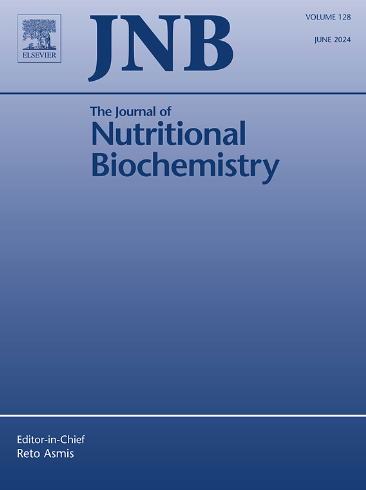姜黄素减轻肥胖驱动的生态失调和肝脏脂肪变性,同时促进高脂肪饮食喂养小鼠白色脂肪组织的褐变和产热。
IF 4.9
2区 医学
Q1 BIOCHEMISTRY & MOLECULAR BIOLOGY
引用次数: 0
摘要
姜黄素,公认其抗氧化和抗炎特性,是一种很有前途的肝脏保护膳食补充剂。然而,其在预防肥胖引起的肝脂肪变性中的作用尚不完全清楚。本研究旨在表明,姜黄素减轻肝脏脂肪变性,促进白色脂肪组织(WAT)的褐变和产热。将雄性C57BL/6小鼠分为标准饲粮(STD)组、STD饲粮中添加100 mg/kg姜黄素组、高脂饲粮(HFD)组和高脂饲粮中添加100 mg/kg姜黄素组,连续4周。与性病小鼠相比,饲喂hfd的小鼠表现出更大的体重、附睾脂肪量、肝脏重量、餐后血糖(PBG)、胰岛素、血浆/肝脏丙氨酸转氨酶(ALT)和甘油三酯(TG)水平,并伴有炎症反应和巨噬细胞浸润。此外,饲喂hfd的小鼠显示肝组织中脂联素、脂联素受体-1和PI3K/AKT磷酸化降低。除肝脏重量外,姜黄素处理的HFD小鼠的这些影响被逆转。姜黄素抑制脂肪细胞肥大,提高附睾脂肪层(EFPs)中PGC-1α、PPARγ和UCP-1蛋白以及Zic1、Prdm16、Tnfrsf9和Tmem26基因的表达。它还显著改变了肠道菌群组成,减少了促炎细菌,如幽门螺杆菌、Oscillospira、副杆菌和Alistipes,从而缓解了肠道生态失调,改善了肥胖相关的代谢参数。综上所述,姜黄素对hfd喂养小鼠肝脏脂肪变性和肥胖的保护作用源于其上调脂联素、增强胰岛素信号、促进WAT褐变、增加产热和调节肠道生态失调的能力。本文章由计算机程序翻译,如有差异,请以英文原文为准。

Curcumin mitigates obesity-driven dysbiosis and liver steatosis while promoting browning and thermogenesis in white adipose tissue of high-fat diet-fed mice
Curcumin, recognized for its antioxidant and anti-inflammatory properties, is a promising dietary supplement for liver protection. However, its role in preventing obesity-induced hepatic steatosis is not fully understood. This study aims to show that curcumin mitigates hepatic steatosis and promotes browning and thermogenesis in white adipose tissue (WAT) under obesity. Male C57BL/6 mice were assigned to four groups: standard diet (STD), STD supplemented with 100 mg/kg curcumin, high-fat diet (HFD), or HFD supplemented with 100 mg/kg curcumin, administered for 4 weeks. Compared to STD mice, HFD-fed mice exhibited significantly greater body weight, epididymal fat mass, liver weight, postprandial blood glucose (PBG), insulin, and plasma/hepatic alanine aminotransferase (ALT) and triglyceride (TG) levels, alongside an inflammatory response and macrophage infiltration. Additionally, HFD-fed mice showed reduced adiponectin, adiponectin receptor-1, and PI3K/AKT phosphorylation in liver tissue. Except for liver weight, these effects were reversed in curcumin-treated HFD mice. Curcumin inhibited adipocyte hypertrophy and elevated the expression of PGC-1α, PPARγ, and UCP-1 proteins, as well as Zic1, Prdm16, Tnfrsf9, and Tmem26 genes in epididymal fat pads (EFPs). It also significantly altered gut microbiota composition, reducing pro-inflammatory bacteria such as Helicobacter, Oscillospira, Parabacteroides, and Alistipes, thereby alleviating intestinal dysbiosis and improving obesity-related metabolic parameters. In conclusion, curcumin’s protective effects against hepatic steatosis and adiposity in HFD-fed mice stem from its ability to upregulate adiponectin, enhance insulin signaling, promote WAT browning, increase thermogenesis, and modulate intestinal dysbiosis.
求助全文
通过发布文献求助,成功后即可免费获取论文全文。
去求助
来源期刊

Journal of Nutritional Biochemistry
医学-生化与分子生物学
CiteScore
9.50
自引率
3.60%
发文量
237
审稿时长
68 days
期刊介绍:
Devoted to advancements in nutritional sciences, The Journal of Nutritional Biochemistry presents experimental nutrition research as it relates to: biochemistry, molecular biology, toxicology, or physiology.
Rigorous reviews by an international editorial board of distinguished scientists ensure publication of the most current and key research being conducted in nutrition at the cellular, animal and human level. In addition to its monthly features of critical reviews and research articles, The Journal of Nutritional Biochemistry also periodically publishes emerging issues, experimental methods, and other types of articles.
 求助内容:
求助内容: 应助结果提醒方式:
应助结果提醒方式:


